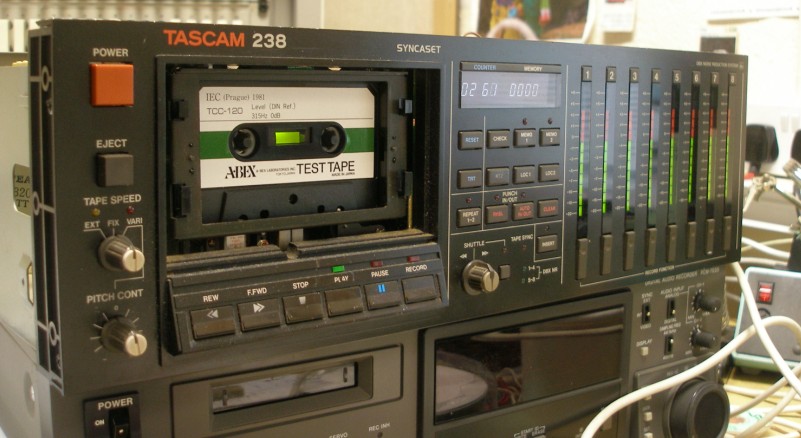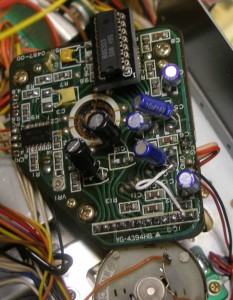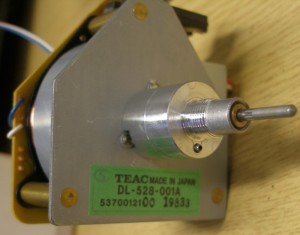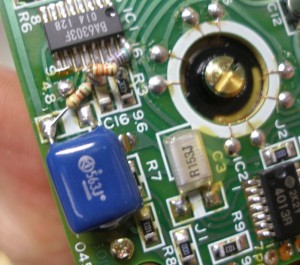We specialise in tape transfers, many of which are multitrack cassette tapes.
Tascam, Fostex and Yamaha sold cassette multitrack recorders in the golden days of home recording in the 1980s and ’90s. The 4 track format was especially popular but an 8 track format was also developed that squeezed even more out of the small tape width of the cassette.
We love these cassette formats and their accessibility helped start many musicians’ careers. Unfortunately one of the best 8 track machines, the Tascam 238 Syncaset also suffers from a common and frustrating problem that renders most of these machines useless over time, the dreaded direct drive capstan motor failure…
The 238 and other 8 track and high quality stereo tape decks, the 688 and 122 MkII and III, used a direct drive capstan motor for precise speed control and reduced speed variation or wow and flutter (w/f). The circuit that controls this motor fails in certain ways causing lack of speed control and in our case the capstan motor wizzing away at a crazy speed, not the 9.5 cm/sec that it should do.

This here is the culprit – you can see the attempted repairs which didn’t ultimately work.
One common failure is that the surface mount electrolytic capacitors fail or their capacitance changes to such an extent to cause speed problems. These can be changed for standard through hole caps but you do need to be very careful as the tracks are damaged very easily – good tools are essential.
The other point of failure in the circuit is the BA6304F SO16 IC – we even changed this but the motor still didn’t turn!
There was some suggestion from previous repairers that the grease at the end of the capstan flywheel hardens over time. increasing the friction and causing problems with the circuit.
This can become frustrating quickly, especially when you have a large archive of cassettes to digitise.
When we can’t repair we reluctantly do the next best thing and buy the whole replacement part but this is another exercise in frustration. Teac parts and Teac UK don’t have any european supply of this capstan motor (part no. 53700075-01) anymore as of November 2011. Interestingly about 6 months ago they did at around £60 GBP, then about 3 months ago they had one left at £160 GBP!
Lots of emails later to Teac US, Teac Canada and Teac Japan there seem to be a nice stock still on shelves somewhere and at reasonable prices UNTIL you ask them to ship to the UK when you discover they can’t do this and I’d need to go through Teac UK!!! I’m pretty persistent but I gave up finally even though some of the support staff tried to be pretty helpful.
We find support for older machines from the original manufacturers is not good generally and unreasonably expensive when you can find it. This is similar across audio and video, semi-pro and professional products. Some companies are easier to deal with and have a better parts situation than others, but stockpiling machines, parts, manuals and obsolete knowledge is the best course of action.
What we finally did that worked and was a good solution was purchase 3 Tascam 122 Mk III stereo cassette decks which use the same but a later revision of the capstan motor, (part no. 53700121-00).

It’s also a good idea once you’ve got the capstan motor apart to clean the old grease from the seat, check the end float which can be adjusted using the screw shown on the left and apply new grease to the capstan end.
Put it all back together – be careful to solder the wires to the motor to the correct pads – they’re different on the 122 and test… Ours worked almost perfectly.
As the transport hadn’t been used for a while the reel motor would intermittently stop as if sensing the tape end. This can sometimes be loose counter belts but on the 238 it’s a digitial counter. We cleaned up the leaf switches on the transport top and also sprayed a small amount of deoxit into the inside of the reel motor. A bit more use and it finally worked to spec…
For 4 track and 8 track multitrack cassette transfer, see our dedicated page, and please contact us for more information.


I have restored several 122 mkII and mkIII decks. I have recapped the capstan motor and still noticed speed problems. What apparently happens is that when the surface mount electrolytics fail, they also deposit conductive electrolyte on to the PC board below. I have had success with cleaning the pc board very thoroughly after removing the surface mount capacitors before installing new caps. You can see evidence of this problem by simply breathing on the motor and noticing the speed change. The conductive material on the pc board is apparently sensitive to moisture. This could be planned obsolescence or bad design. The capacitors should have been tantalums in the first place, there would never be such a problem in that case.
FRAN FLYNN
I’m working on a 122MKIII with speed problems. (plays too slow when cold, but returns gradually to almost normal speed when warmed, polarized capacitors have been replaced). My board was clean and looked fine, no leakage. I did try what you said: I breathed on the circuit…. it almost instantly speeded up. I blown and slowed it down again. WOW!! Now I have more clues on what to test
I was looking at this page, dreading changing caps, when I tried something I never would’ve suspected. I adjusted the set screw on the back of the direct drive motor, (2nd picture, just visible behind the big black cap), and dang if it didn’t start running at the correct speed. Still makes a slight bit of noise, so maybe I’ll have to clean and oil the contact point between the capstan and the set screw, but I’ll be damned. It freakin’ works! Thank you!
Hi, same trouble here with my 238, plays constant at I/2 speed. The correct speed pads are jumped. Interestingly when I also jump the 4.8 pads the speed goes too fast. There is something just above the big screw head in the 1st pic marked VRI that can be turned to affect speed slightly but not enough.
@Jess – Sorry but I don’t see any big black cap on the 2nd pic so not sure which screw to turn. And does the motor have to be removed to get to it? Thanks.
@Steven: Just saw your question, but the screw I’m talking about is the one that provides tension directly to the rear of the capstan. In the above text, it’s more clearly seen, and referred to thusly: “The 122 motor has a few factory extras, such as these resistors, shown here:” It’s the big, brass flathead screw in the upper right of the photo. Hope that’s a bit clearer, and no, the 238 motor does not have to be removed to access it.
As for my 238, it’s gone from bad to worse, so I’ll probably have to have it serviced.
I’ve got two 238’s and both are now useless. The motors totally do not work at all. I have 60 fully arranged songs recorded on this machine and cannot even transfer them to my Korg 16 track digital because the motor is shot to shit. This is horrendous customer care and service. I think people should write to Teac and ask them to re-manufacture the capstan motor so their customers are not left in the lurch like this. I think it’s terrible the way these companies get our money then drop us like hot potatoes. korg is guilty of the same inconsiderate behavior. If they’re not going to keep making replacement parts, then make damn sure that the parts in the machines they sell us will NOT wear out. Is that asking too much? The refrigerator my parents bought back in the 1950’s is STILL RUNNING! It’s kept in the garage now to store cold beverages, but it was made to last. Back then, if you made it any other way you would have NO customers. It’s time consumers started demanding this same kind of excellence from the people who sell us goods. I paid $1400 for my Tascam 238 when it was new, and that was a LOT OF MONEY for a poor musician. I deserve better than what they’ve given me, and so do you. Write to them and tell them you’re MAD AS HELL AND YOU’RE NOT GOING TO TAKE IT ANYMORE!
I have a 238 with noise from the capstan motor but doing the right speed
can I use both 122 MKII and MKIII to replace the board and motor?
Hi all – my 238s was jet-engining… running free and fast, so I adjusted the big brass end -float screw and have got it to a reasonable speed again – if the screw isn’t perfect I can hear proper ‘chuntering’ as (I guess) it hunts for the right speed. But my question is this – how is the capstan motor assembly properly anchored to the rest of the transport? Mine wobbles about all over the place with application of light finger pressure, and again that has obvious wow and warble as the tape gets more or less pressure from the capstan.. It seems like it’s barely fixed in there at all???? Also my motor comes in a metal case (also fairly loose) – I’ve not seen pictures of one like that anywhere on the interwebs, but otherwise looks like the ‘late model’ motor on this page, with the extra resistors near the 6303f chip… Perhaps it has never actually been fixed in place properly since some previous owner swapped in a newer motor……